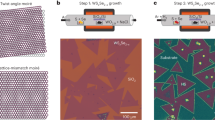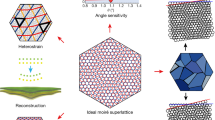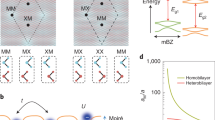Abstract
Two-dimensional moiré materials are formed by overlaying two layered crystals with small differences in orientation or/and lattice constant, where their direct coupling generates moiré potentials. Moiré materials have emerged as a platform for the discovery of new physics and device concepts, but while moiré materials are highly tunable, once formed, moiré lattices cannot be easily altered. Here we demonstrate the electrostatic imprinting of moiré lattices onto a target monolayer semiconductor. The moiré potential—created by a lattice of electrons that is supported by a Mott insulator state in a remote MoSe2/WS2 moiré bilayer—imprints a moiré potential that generates flat bands and correlated insulating states in the target monolayer and can be turned on/off by gate tuning the doping density of the moiré bilayer. Additionally, we studied the interplay between the electrostatic and structural relaxation contributions to moiré imprinting. Our results demonstrate a pathway towards gate control of moiré lattices.
This is a preview of subscription content, access via your institution
Access options
Access Nature and 54 other Nature Portfolio journals
Get Nature+, our best-value online-access subscription
$29.99 / 30 days
cancel any time
Subscribe to this journal
Receive 12 print issues and online access
$259.00 per year
only $21.58 per issue
Buy this article
- Purchase on Springer Link
- Instant access to full article PDF
Prices may be subject to local taxes which are calculated during checkout




Similar content being viewed by others
Data availability
Source data are provided with this paper. Additional data that support the findings of this study are available from the corresponding authors upon reasonable request.
References
Andrei, E. Y. et al. The marvels of moiré materials. Nat. Rev. Mater. 6, 201–206 (2021).
Andrei, E. Y. & MacDonald, A. H. Graphene bilayers with a twist. Nat. Mater. 19, 1265–1275 (2020).
Balents, L., Dean, C. R., Efetov, D. K. & Young, A. F. Superconductivity and strong correlations in moiré flat bands. Nat. Phys. 16, 725–733 (2020).
Cao, Y. et al. Unconventional superconductivity in magic-angle graphene superlattices. Nature 556, 43–50 (2018).
Kennes, D. M. et al. Moiré heterostructures as a condensed-matter quantum simulator. Nat. Phys. 17, 155–163 (2021).
Mak, K. F. & Shan, J. Semiconductor moiré materials. Nat. Nanotechnol. 17, 686–695 (2022).
Wu, F., Lovorn, T., Tutuc, E. & MacDonald, A. H. Hubbard model physics in transition metal dichalcogenide moire bands. Phys. Rev. Lett. 121, 026402 (2018).
Wu, F., Lovorn, T., Tutuc, E., Martin, I. & MacDonald, A. H. Topological insulators in twisted transition metal dichalcogenide homobilayers. Phys. Rev. Lett. 122, 086402 (2019).
Bistritzer, R. & MacDonald, A. H. Moiré bands in twisted double-layer graphene. Proc. Natl Acad. Sci. USA 108, 12233–12237 (2011).
Li, H. et al. Imaging moiré flat bands in three-dimensional reconstructed WSe2/WS2 superlattices. Nat. Mater. 20, 945–950 (2021).
Xu, Y. et al. Creation of moiré bands in a monolayer semiconductor by spatially periodic dielectric screening. Nat. Mater. 20, 645–649 (2021).
Kim, K. et al. Spin-conserving resonant tunneling in twist-controlled WSe2-hBN-WSe2 heterostructures. Nano Lett. 18, 5967–5973 (2018).
Tang, Y. et al. Dielectric catastrophe at the Wigner-Mott transition in a moiré superlattice. Nat. Commun. 13, 4271 (2022).
Xu, Y. et al. Correlated insulating states at fractional fillings of moiré superlattices. Nature 587, 214–218 (2020).
Shi, Q. et al. Bilayer WSe2 as a natural platform for interlayer exciton condensates in the strong coupling limit. Nat. Nanotechnol. 17, 577–582 (2022).
Xu, Y. et al. A tunable bilayer Hubbard model in twisted WSe2. Nat. Nanotechnol. 17, 934–939 (2022).
Chen, D. et al. Excitonic insulator in a heterojunction moiré superlattice. Nat. Phys. 18, 1171–1176 (2022).
Li, T. et al. Quantum anomalous Hall effect from intertwined moiré bands. Nature 600, 641–646 (2021).
Zhao, W. et al. Gate-tunable heavy fermions in a moiré Kondo lattice. Nature 616, 61–65 (2023).
Gu, J. et al. Dipolar excitonic insulator in a moiré lattice. Nat. Phys. 18, 395–400 (2022).
Zhang, Z. et al. Correlated interlayer exciton insulator in heterostructures of monolayer WSe2 and moiré WS2/WSe2. Nat. Phys. 18, 1214–1220 (2022).
Huang, D., Choi, J., Shih, C.-K. & Li, X. Excitons in semiconductor moiré superlattices. Nat. Nanotechnol. 17, 227–238 (2022).
Regan, E. C. et al. Emerging exciton physics in transition metal dichalcogenide heterobilayers. Nat. Rev. Mater. 7, 778–795 (2022).
Wilson, N. P., Yao, W., Shan, J. & Xu, X. Excitons and emergent quantum phenomena in stacked 2D semiconductors. Nature 599, 383–392 (2021).
Mak, K. F. & Shan, J. Photonics and optoelectronics of 2D semiconductor transition metal dichalcogenides. Nat. Photon. 10, 216–226 (2016).
Zeng, Y. et al. Exciton density waves in Coulomb-coupled dual moiré lattices. Nat. Mater. 22, 175–179 (2023).
Regan, E. C. et al. Mott and generalized Wigner crystal states in WSe2/WS2 moiré superlattices. Nature 579, 359–363 (2020).
Tang, Y. et al. Simulation of Hubbard model physics in WSe2/WS2 moiré superlattices. Nature 579, 353–358 (2020).
Raja, A. et al. Coulomb engineering of the bandgap and excitons in two-dimensional materials. Nat. Commun. 8, 15251 (2017).
Ma, L. et al. Strongly correlated excitonic insulator in atomic double layers. Nature 598, 585–589 (2021).
Li, H. et al. Imaging two-dimensional generalized Wigner crystals. Nature 597, 650–654 (2021).
Shimazaki, Y. et al. Optical signatures of periodic charge distribution in a Mott-like correlated insulator state. Phys. Rev. 11, 021027 (2021).
Li, T. et al. Charge-order-enhanced capacitance in semiconductor moiré superlattices. Nat. Nanotechnol. 16, 1068–1072 (2021).
Liu, X. et al. Visualizing broken symmetry and topological defects in a quantum Hall ferromagnet. Science 375, 321–326 (2022).
Jin, C. et al. Stripe phases in WSe2/WS2 moiré superlattices. Nat. Mater. 20, 940–944 (2021).
Halbertal, D. et al. Multilayered atomic relaxation in van der Waals heterostructures. Phys. Rev. 13, 011026 (2023).
Zhang, Y., Yuan, N. F. Q. & Fu, L. Moiré quantum chemistry: charge transfer in transition metal dichalcogenide superlattices. Phys. Rev. B 102, 201115 (2020).
Shimazaki, Y. et al. Strongly correlated electrons and hybrid excitons in a moiré heterostructure. Nature 580, 472–477 (2020).
Wang, L. et al. One-dimensional electrical contact to a two-dimensional material. Science 342, 614–617 (2013).
Wang, G. et al. Colloquium: excitons in atomically thin transition metal dichalcogenides. Rev. Mod. Phys. 90, 021001 (2018).
Rhodes, D., Chae, S. H., Ribeiro-Palau, R. & Hone, J. Disorder in van der Waals heterostructures of 2D materials. Nat. Mater. 18, 541–549 (2019).
Acknowledgements
This work was supported by the Gordon and Betty Moore Foundation, grant DOI: 10.37807/GBMF11563 (experimental design and analysis), the Air Force Office of Scientific Research MURI under award number FA9550-18-1-0480 (device fabrication) and the National Science Foundation grant DMR-2114535 (optical sensing measurement). The study was performed in part at the Cornell NanoScale Facility, a member of the National Nanotechnology Coordinated Infrastructure supported by National Science Foundation grant NNCI-2025233. The growth of the hBN crystals was supported by the Elemental Strategy Initiative of the Ministry of Education, Culture, Sports, Science and Technology, Japan and the Core Research for Evolutional Science and Technology programme of the Japan Science and Technology Agency (grant no. JPMJCR15F3). P.K. acknowledges a postdoc fellowship from the Swiss National Science Foundation.
Author information
Authors and Affiliations
Contributions
J.G. fabricated the devices. J.G., J.Z. and P.K. performed the measurements. J.G. analysed the data. K.W. and T.T. grew the bulk hBN crystals. J.G., K.F.M. and J.S. designed the scientific objectives, oversaw the project and cowrote the manuscript. All authors discussed the results and commented on the manuscript.
Corresponding authors
Ethics declarations
Competing interests
The authors declare no competing interests.
Peer review
Peer review information
Nature Materials thanks Weibo Gao, Canxun Zhang and the other, anonymous, reviewer(s) for their contribution to the peer review of this work.
Additional information
Publisher’s note Springer Nature remains neutral with regard to jurisdictional claims in published maps and institutional affiliations.
Extended data
Extended Data Fig. 1 Optical image of device 1 and 2.
The target MoSe2 monolayer (white) and the moiré bilayer with monolayer MoSe2 (blue) and WS2 (red) are labeled and outlined. The effective area of the devices is shaded in grey. The scale bars are 10 μm.
Extended Data Fig. 2 Charge neutrality of the sensor.
a. Conduction band alignment for the TMD layers involved in the device structure under zero external electric field. b-d, First energy derivative of the sensor reflection contrast spectrum \((\frac{dR}{d{\epsilon }})\) as a function of the total filling factor. The gate voltages are scanned along the three arrowed lines in Fig. 1b with \({\nu }_{m} > 0\) and \({\nu }_{t}=0\) (b), \({\nu }_{m}=0\) and \({\nu }_{t} > 0\) (c) and \({\nu }_{m}=1\) and \({\nu }_{t} > 0\) (d). Incompressible states are labeled by their filling factors. The 1 s and 2 s excitons of the WSe2 sensor layer as well as the 2 s exciton of the MoSe2 target layer are labeled. The robust 1 s exciton resonance of the WSe2 layer, irrespective of the filling factor, demonstrates the charge neutrality of the sensor.
Extended Data Fig. 3 Gate dependent reflectance contrast spectrum (device 1).
a,b, Gate voltage \(({V}_{t}+{V}_{b})\) dependent reflectance contrast spectrum at electric field 0.045 V/nm (a) and 0.12 V/nm (b). Five different exciton species can be identified: the fundamental moiré exciton MX1, the excited moiré exciton MX2, the neutral (X) and charged (X-) excitons of the target layer, and the 2 s exciton of the sensor layer. The red dashed arrows denote the onset of electron doping in the device. The moiré (target) layer is first doped at low (high) electric field.
Extended Data Fig. 4 Electrostatics phase diagram (device 1).
a-d, Electric-field (E) and gate \(({V}_{t}+{V}_{b})\) dependences of the spectral feature corresponding to the sensor 2 s exciton (a), charged exciton X−of the target layer (b), moiré exciton MX1 (c) and MX2 (d). The analysis of the reflectance contrast spectra is described in Methods. The X− reflectance (b) determines the boundary between the doped (high) and neutral (low) target layer (black solid line). The MX1 reflectance (c) determines the boundary between the doped (low) and neutral (high) moiré layer (pink solid line). The MX2 reflectance (d) determines the boundaries of the \(({\nu }_{m},{\nu }_{t})=(1,{\nu }_{t})\) region with enhanced contrast (pink dashed lines). These boundaries are included in a.
Extended Data Fig. 5 Gate dependent reflectance contrast spectrum (device 2).
a,b, Gate voltage (\({V}_{t}+{V}_{b}\)) dependent reflectance contrast spectrum at electric field 0.07 V/nm (a) and 0.16 V/nm (b). Similar to Extended Data Fig. 3, five different exciton species can be identified. The red dashed arrows denote the onset of electron doping in the device.
Extended Data Fig. 6 Electrostatics phase diagram (device 2).
a-d, Electric-field (E) and gate \(({V}_{t}+{V}_{b})\) dependences of the spectral feature corresponding to the sensor 2 s exciton (a), charged exciton X−of the target layer (b), moiré exciton MX1 (c) and MX2 (d). The analysis of the reflectance contrast spectra is described in Methods. The X− reflectance (b) determines the boundary between the doped (high) and neutral (low) target layer (black solid line). It also determines the boundaries (black dashed lines) of the \(({\nu }_{m},{\nu }_{t})=({\nu }_{m},1)\) region. The MX1 reflectance (c) determines the boundary between the doped (low) and neutral (high) moiré layer (pink solid line). The MX2 reflectance (d) determines the boundaries of the \(({\nu }_{m},{\nu }_{t})=(1,{\nu }_{t})\) region with enhanced contrast (pink dashed lines). These boundaries are included in a.
Extended Data Fig. 7 Electrostatic potential imprinted from a triangular electron lattice.
a, Calculated electrostatic potential profile in a plane that is 1 nm above a triangular electron lattice. To mimic the real moiré lattice, we set the period to 8 nm in the calculation and used the dielectric constant of hBN. The triangular electron lattice imprints a honeycomb potential profile (black line denotes the unit cell and dots denote the sublattice sites). b, Electrostatic potential along the dashed line in a. It shows a trapping potential depth of about 4 meV.
Extended Data Fig. 8 Electric field dependence of the 2 s intensity in device 2.
a, Second energy derivative of the 2 s exciton reflectance contrast \((\frac{{d}^{2}R}{d{\epsilon }^{2}})\) as function of the gate voltage \(({V}_{t}+{V}_{b})\) and the electric field (E) for device 2. b, Extracted 2 s peak intensity as a function of the electric field along the red dashed line in a. The blue and green regions correspond to \({\nu }_{m}=1\) and \({\nu }_{m}=0\), respectively. The enhanced 2 s intensity in the blue region suggests a more robust correlated insulating state at \({\nu }_{t}=1\) due to the electrostatic imprinting effect.
Extended Data Fig. 9 Results from additional devices.
a,b, First energy derivative of the sensor 2 s spectrum \((\frac{dR}{d{\epsilon }})\) as a function of the gate voltage \(({V}_{t}+{V}_{b})\) for device 3 with a 4-layer hBN spacer (a) and device 4 with a 2-layer hBN spacer (b). The gate voltage \(({V}_{t}+{V}_{b})\) controls the total filling factor under a constant electric field (controlled by \({V}_{t}-{V}_{b}\)). We label the incompressible states \(({\nu }_{m},{\nu }_{t})=(\mathrm{0,1})\) and \((\mathrm{1,1})\) on the left and right panels, respectively.
Supplementary information
Source data
Source Data Fig. 1
Source data for Fig. 1.
Source Data Fig. 2
Source data for Fig. 2.
Source Data Fig. 3
Source data for Fig. 3.
Source Data Fig. 4
Source data for Fig. 4.
Source Data Extended Data Fig. 2
Source data for Extended Data Fig. 2.
Source Data Extended Data Fig. 3
Source data for Extended Data Fig. 3.
Source Data Extended Data Fig. 4
Source data for Extended Data Fig. 4.
Source Data Extended Data Fig. 5
Source data for Extended Data Fig. 5.
Source Data Extended Data Fig. 6
Source data for Extended Data Fig. 6.
Source Data Extended Data Fig. 7
Source data for Extended Data Fig. 7.
Source Data Extended Data Fig. 8
Source data for Extended Data Fig. 8.
Source Data Extended Data Fig. 9
Source data for Extended Data Fig. 9.
Rights and permissions
Springer Nature or its licensor (e.g. a society or other partner) holds exclusive rights to this article under a publishing agreement with the author(s) or other rightsholder(s); author self-archiving of the accepted manuscript version of this article is solely governed by the terms of such publishing agreement and applicable law.
About this article
Cite this article
Gu, J., Zhu, J., Knuppel, P. et al. Remote imprinting of moiré lattices. Nat. Mater. 23, 219–223 (2024). https://doi.org/10.1038/s41563-023-01709-8
Received:
Accepted:
Published:
Issue Date:
DOI: https://doi.org/10.1038/s41563-023-01709-8
This article is cited by
-
A moiré proximity effect
Nature Materials (2024)



